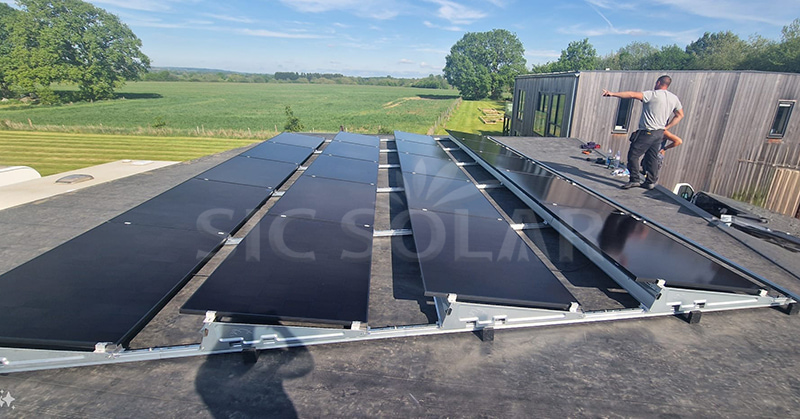Flat roofs are a popular choice for both residential and commercial solar installations, thanks to their ample space and ease of access. However, one of the key challenges with flat roof installations is determining the optimal tilt angle for solar panels. Unlike pitched roofs, which naturally provide an angle to the panels, flat roofs require additional consideration to ensure solar panels are positioned at the correct tilt to maximize energy production.

1. Why Is Tilt Angle Important for Solar Panels?
The tilt angle of solar panels plays a significant role in determining how much sunlight they can capture. Optimal tilt ensures that panels absorb the maximum amount of solar energy throughout the day. Key benefits of the correct tilt angle include:
- Maximized Energy Production: Panels tilted at the right angle can increase the energy output of the system by capturing more sunlight.
- Reduced Shading: A proper tilt angle minimizes the chances of shading, which can significantly reduce the efficiency of solar panels.
- Better Snow and Rain Drainage: Panels tilted at an optimal angle can allow snow or rain to slide off more easily, preventing accumulation that could hinder performance.
On flat roofs, achieving the ideal tilt requires additional design considerations.
2. Solutions for Adjusting the Tilt Angle on Flat Roofs
There are several ways to adjust the tilt of solar panels on flat roofs, each with its own set of advantages:
A. Ballasted Systems
A ballasted mounting system uses weights, such as concrete blocks, to hold the solar panels in place without the need for roof penetration. This system is often used for flat roof installations where the integrity of the roof must be preserved. The ballasted system typically includes adjustable brackets that allow for tilting the panels to the desired angle.
Advantages:
- No roof penetrations, which reduces the risk of leaks.
- Adjustable tilt angles to ensure maximum energy production, typically ranging from 10° to 30° depending on the location and panel orientation.
- Easy to install and modify if necessary, making it ideal for retrofits or installations on roofs with limited structural support.
SIC Solar ballasted mounting systems are designed to provide stable support while allowing flexible tilt angles, ensuring that your solar panels perform optimally throughout the year.
B. Penetrating Systems with Adjustable Rails
In cases where penetration into the roof structure is allowed, penetrating mounting systems are often used. These systems involve securing the panels to the roof using rails that are anchored into the roof structure. The rails can be adjusted to set the tilt angle of the panels.
Advantages:
- More flexibility in choosing the optimal tilt angle, especially for larger systems.
- Provides a secure and durable foundation for solar panels, with excellent wind resistance.
- The angle can be adjusted based on the geographical location to ensure maximum solar exposure.
SIC Solar penetrating systems offer easy adjustments and are built to handle heavy-duty applications, ensuring long-lasting durability and performance.
C. Adjustable Mounting Systems
Some flat roof installations use adjustable mounting systems that allow the tilt angle to be fine-tuned during installation. These systems typically feature tilt legs or rails that can be set at specific angles to ensure maximum sunlight exposure.
Advantages:
- Customization: These systems are designed to allow precise control over tilt angles.
- Improved performance by ensuring that the panels are positioned for the best possible sunlight exposure.
- Efficient installation process that accommodates various panel configurations.
SIC Solar offers adjustable tilt mounting systems that allow you to fine-tune the panel angle to match your roof’s specific needs and location.
3. Factors to Consider When Choosing the Tilt Angle for a Flat Roof
Several factors should be taken into account when determining the tilt angle for solar panels on flat roofs:
A. Geographic Location
The ideal tilt angle is heavily influenced by your location. For example:
- In northern latitudes, panels may need a steeper angle to capture sunlight during the winter months.
- In southern latitudes, a shallower tilt might be optimal to take advantage of sunlight during the summer months.
A south-facing orientation combined with the correct tilt angle ensures that panels capture the most sunlight.
B. Seasonal Variations
Adjusting the tilt angle based on the season can further optimize energy production. For example:
- A steeper angle during winter helps panels catch low-angle sunlight.
- A shallower angle in summer allows panels to better capture sunlight when it’s higher in the sky.
SIC Solar adjustable systems allow for such seasonal adjustments, enhancing the flexibility and efficiency of your installation.
C. Roof and Structural Constraints
The size and shape of the roof, as well as any structural constraints, will impact the tilt angle. For example, large commercial roofs may have more flexibility for tilt adjustments, while residential flat roofs may have limitations in space or structural support.
SIC Solar modular and customizable systems are designed to work within these constraints, providing a solution that meets your roof’s specific needs.
4. Why Choose SIC Solar for Your Flat Roof Installation?
SIC Solar is known for providing high-quality, durable mounting solutions for solar panel installations on flat roofs. Here’s why you should consider SIC Solar for your project:
✅ Flexible Tilt Angle Adjustments: SIC Solar mounting systems are designed to allow for easy tilt angle adjustments, ensuring optimal energy production year-round.
✅ No Roof Penetration Options: With ballasted systems, you can install your panels without compromising the integrity of your roof.
✅ High-Quality Materials: Made from corrosion-resistant materials, SIC Solar systems are built to last and withstand harsh weather conditions.
✅ Efficient and Cost-Effective: SIC Solar provides quick and easy-to-install solutions, reducing labor costs and installation time.
✅ Custom Solutions: Whether for residential, commercial, or industrial applications, SIC Solar can tailor its systems to fit your specific needs.